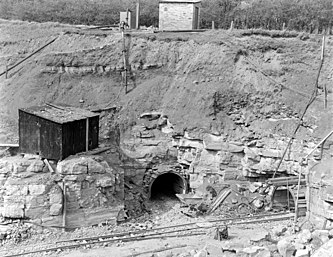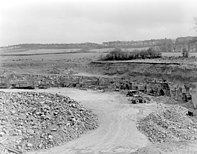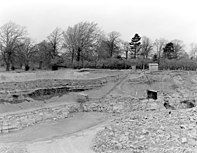Darnley Lime Works Tramway and Mineral Railway
| Darnley Lime Works Tramway and Mineral Railway | |||||||||||||||||||||||||||||||||||||||||
|---|---|---|---|---|---|---|---|---|---|---|---|---|---|---|---|---|---|---|---|---|---|---|---|---|---|---|---|---|---|---|---|---|---|---|---|---|---|---|---|---|---|
|
Darnley Quarry, 1959
| |||||||||||||||||||||||||||||||||||||||||
| Gauge : | 610 mm ( 2 foot track ) | ||||||||||||||||||||||||||||||||||||||||
|
|||||||||||||||||||||||||||||||||||||||||
The Darnley Lime Works Tramway and Mineral Railway were a light railway and a works railway in what is now Dams to Darnley Country Park (s) in Renfrewshire , 9.7 km southwest of Glasgow , which operated successively from at least 1898 to 1959.
history
First mines
The Darnley area has been mining since 1610, as evidenced by a lease between Sir John Maxwell, John Hall and George Stephenson in the Pollock Estate Papers. In it, Stevenson acquired the rights to mine limestone at Over Darnley. Coal was already being mined in 1615 , as evidenced by a contract between Sir John Maxwell and Robert Milne from April 1615.
Old maps show how extensive the mining was in different places in this area. A map by John Ainslie (en) from 1800 shows limestone quarries near Darnley Mill on the east side of Brock Burn and two above Upper Darnley.
Tramway
The second edition of the Ordnance Survey Map (1896–1899) shows the quarry recorded by Ainslie at the site of today's junction no. 3 of the M77 , from the lime with a tramway called lime kilns to the Darnley Lime Works on the east side des Brock Burn, which were located a little south of today's World-Buffet-Restaurant at the junction of Corselet Road and Nitshill Road.
Mineral Railway
The works railway, presumably standard gauge , called Mineral Railway , which was also drawn on the map of Ainslie, led from the lime works south to the quarries south of today's Southpark Village. There was another quarry to the west of where the Aurs Burn meets the Brock Burn.
The map from 1914–1915 shows a tremendous increase in mining and quarrying activities within the area. On the west side of Brock Burn, various light railways can be seen running from the Waulkmill Mine in Waulkmill Glen to the cement works north of North Brae Farm. The quarries south of Southpark Village were known as the Darnley Fireclay Mine at the time and the lime works were now called Darnley Lime and Fireclay Works.
Chamotte
The fire clay called fireclay lay in seams up to two meters thick under the limestone and were mined at various times, especially around 1900. Large fireclay ovens made bricks, pipes, and plumbing products. The light railroad, known as the tramway, appears to have been decommissioned because the quarry it once served is recorded on the map as an old quarry . In the late 1930s, the Darnley Fireclay Mine was known as Upper Darnley Quarry and the Darnley lime works as the Arden Lime Works.
limestone
While some of the limestone was used as fertilizer lime for soil improvement in agriculture in the eighteenth century , Darnley lime was mainly used to make bricks for the construction of residential buildings, for example on the Williamwood Estate. Other later uses included road construction and as its waterproofing properties were recognized it became more widely used. The lime was shipped across the country and became one of the most popular building materials in Britain, appearing in British Standards until the 1950s .
Landfill and park
Mining continued in this area until the late 1950s or early 1960s. The old quarries were then used as landfills . The largest landfill is east of Corselet Road, but also extends west of the road and beyond the landscaped park towards the B&Q hardware store. The areas where the land has been replenished appear coarse and hilly, with rough, mossy vegetation. In some places there has been obvious subsidence and debris protruding from the ground including brick, metal and rubble. Elsewhere, the landfill is adjacent to non-heaped, high-quality land. The edges where the land has not been landscaped can still be seen in Dams to Darnley Country Park.
Individual evidence
- ^ Darnley Mill (Corn) on Renfrewshire, Sheet XII (incl. Eastwood, Neilston, Paisley). Publication date 1864.
- ↑ a b Mining, quarrying and the qandfill legacy.
- ^ Dams to Darnley Country Park. Development and Management Plan, 2011-2016. April 2013.
Coordinates: 55 ° 48 ′ 25 " N , 4 ° 20 ′ 53.6" W.




